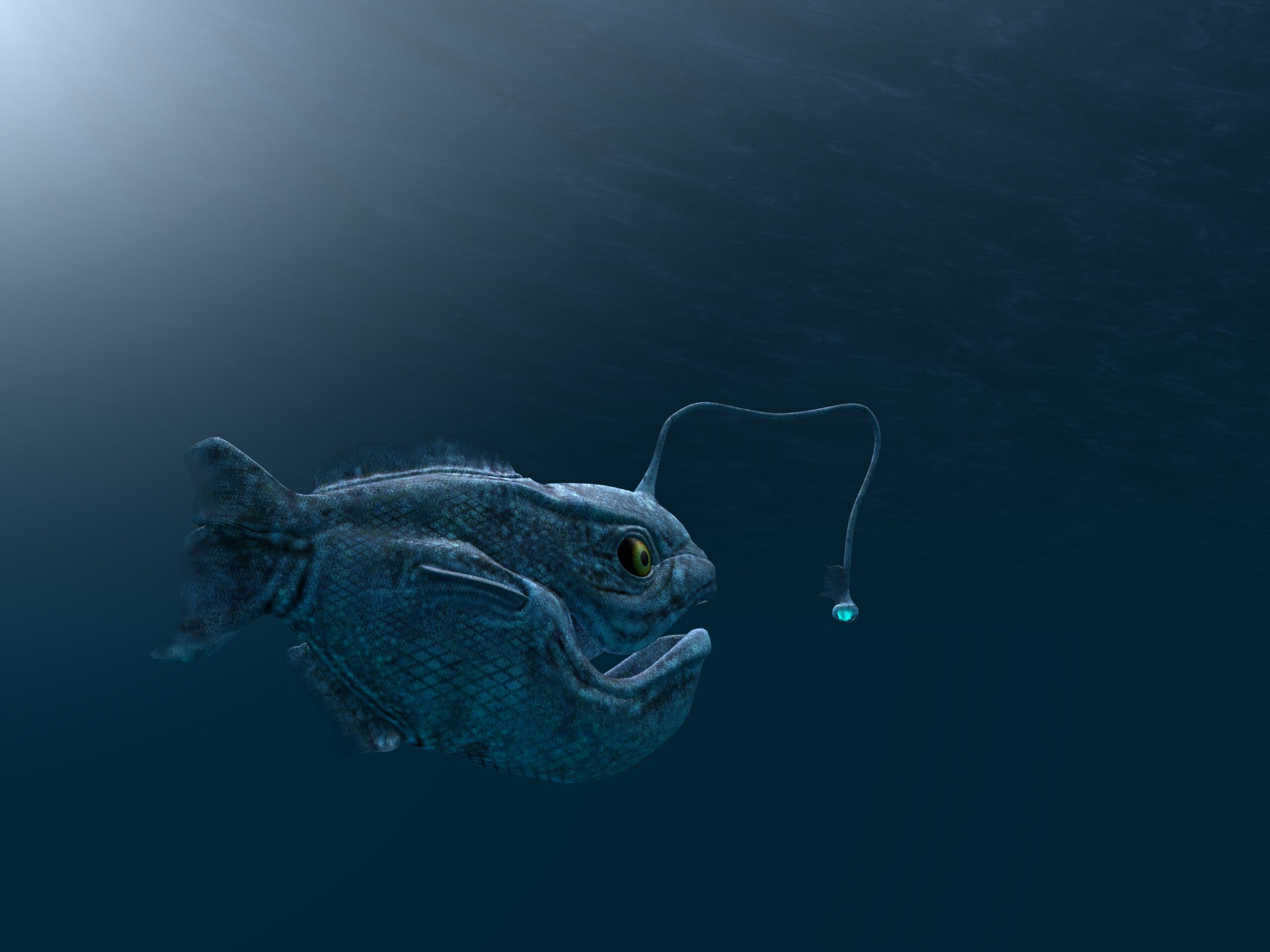Key Takeaways
- Anglerfish are a diverse group of deep-sea fish with over 200 known species.
- They exhibit a variety of adaptations for survival, including bioluminescent lures and the ability to swallow prey larger than themselves.
- Despite their elusive nature, angler fish are still alive and thriving in the depths of the ocean.
Description of Anglerfish
Anglerfish are a type of fish that are famous for their unique method of hunting. They are deep-sea predators that are known for their distinctive appearance and behavior. In this section, we will explore the anatomy, behavior, and scientific classification of these fascinating creatures.Anatomy of Anglerfish
Anglerfish come in a variety of shapes and sizes, but they are typically rounded in shape with a long growth sprouting from the head. They have a large head and mouth, with sharp teeth that are used to catch their prey. Their skin is usually a dark color, which helps them blend in with their surroundings in the deep sea. One of the most distinctive features of anglerfish is their rod-like structure that protrudes from their head. This structure is used to lure in prey, which is then captured by the anglerfish’s sharp teeth. The lure is usually luminescent, which makes it easier for the anglerfish to attract prey in the dark depths of the ocean.Behavior of Anglerfish
Anglerfish are known for their unique behavior, particularly in terms of their reproduction. In some species of deep-sea anglerfish, the males are much smaller than the females and are dependent on them for survival. The males attach themselves to the females and essentially become a part of their body, sharing nutrients and even blood. This is known as sexual symbiosis and is one of the most extreme examples of sexual dimorphism in the animal kingdom.Scientific Classification of Anglerfish
Anglerfish belong to the scientific order Lophiiformes, which includes over 300 species of fish. They are classified into several families, including the Ceratiidae, which includes some of the most well-known deep-sea anglerfish species. The scientific classification of anglerfish is as follows:- Kingdom: Animalia
- Phylum: Chordata
- Class: Actinopterygii
- Order: Lophiiformes
- Family: Ceratiidae
Do Angler Fish Still Exist in the Present Day?
Yes, anglerfish still exist in the present day. While they are not commonly seen due to their deep-sea habitat, they are known to inhabit waters all around the world. Despite their unusual appearance and behavior, anglerfish play an important role in the ecosystem of the deep sea.Habitat and Distribution
Anglerfish are deep-sea predators that can be found in various parts of the world, including the Atlantic and Antarctic oceans. They are known for their unique method of hunting, which involves using a bioluminescent lure to attract prey. Most species of anglerfish are found in deep-sea environments, where they live on the sea floor at depths of up to a mile or more. They are adapted to the extreme pressures and low temperatures of the deep sea, and have evolved specialized features such as large jaws and expandable stomachs to help them survive in this harsh environment. While some species of anglerfish are found in shallow, tropical waters, the majority of species are found in the deep sea. They are distributed worldwide, with some species found in the Atlantic Ocean and others in the Antarctic Ocean. In North America, anglerfish are found primarily in the deep waters off the coast of New England and Canada. They are also found in other parts of the world, including the waters around Japan and Australia. Overall, anglerfish are a fascinating and unique group of deep-sea predators that have adapted to survive in some of the harshest environments on Earth.Physical Characteristics
Anglerfish are known for their unique physical characteristics, which are specifically adapted to their deep-sea habitat. These creatures are usually dark brown or black in color, and their bodies are flattened and rounded in shape, with an oversized head and mouth. One of the most distinctive features of the anglerfish is its bioluminescent lure, called an esca, which is located on the end of a long spine protruding from the top of its head. This glowing lure is used to attract prey towards the anglerfish’s sharp teeth and fang-like jaws. Anglerfish exhibit extreme sexual dimorphism, with males being much smaller than females. In some species, males are even parasitic, attaching themselves to the female’s body and living off her nutrients. Females of some species can grow up to 3.3 feet in length and weigh up to 110 pounds, while males are typically less than an inch long. The dorsal fin of the anglerfish is long and stretches along the length of its body. Overall, anglerfish are fascinating creatures with unique physical adaptations that allow them to survive in the harsh conditions of the deep sea.Predation and Diet
Anglerfish are carnivorous and are known for their unique hunting method. They are ambush predators, using their bioluminescent lure to attract prey, mostly small fish and crustaceans, towards their large mouth. Once the prey is close enough, the anglerfish will quickly snap its jaws shut, consuming the catch whole. Due to their deep-sea habitat, anglerfish have few natural predators. However, some larger predators such as goosefish and sharks have been known to feed on anglerfish. The anglerfish’s stomach is adapted to digest large prey, and it can distend both its jaw and stomach to swallow prey up to twice its size. The digestion process can take a long time due to the low temperature of the deep sea. Fishing for anglerfish is not common due to their deep-sea habitat and the difficulty of catching them. However, some commercial fishing operations have been known to catch anglerfish as bycatch. In summary, anglerfish are deep-sea predators that use their bioluminescent lure to attract small fish and crustaceans towards their large mouth. They have few natural predators and can consume prey up to twice their size. While fishing for anglerfish is not common, they can be caught as bycatch in commercial fishing operations.Reproduction
https://www.youtube.com/watch?v=XhsyZnVx2rQ&embed=true Anglerfish are known for their unusual and fascinating reproductive habits. The process of anglerfish reproduction involves sexual dimorphism, where the male is significantly smaller than the female. In some species, the male can be up to ten times smaller than the female. The male anglerfish has a keen sense of smell and is attracted to the pheromones released by the female. Once the male finds a female, he bites onto her skin and releases an enzyme that fuses their tissues together. Over time, the male’s body becomes absorbed into the female’s, and the two fish become a single organism. The female anglerfish is the dominant partner in this relationship. She provides all the resources necessary for reproduction, including nourishment and oxygen. The male’s only purpose is to fertilize the female’s eggs. The female anglerfish has a pair of ovaries that produce eggs. Once the eggs are fertilized, they develop into small larvae that are released into the water. The larvae eventually grow into adult anglerfish. It’s worth noting that not all anglerfish species exhibit this extreme form of sexual dimorphism and symbiosis. For example, the footballfish, a type of anglerfish, has more typical reproductive habits. The male and female footballfish are similar in size, and the male does not become absorbed into the female’s body. Overall, the process of anglerfish reproduction is a fascinating example of the diversity of life on Earth.Adaptations and Survival
https://www.youtube.com/watch?v=TmwBE8VkATw&embed=true Anglerfish are known for their unique adaptations that help them survive in the deep sea. These adaptations include their ability to lure prey with their bioluminescent “fishing rods” and their ability to hide and camouflage themselves in their benthic environment. One of the most fascinating adaptations of the anglerfish is their ability to fuse with their mates. In some species, the male anglerfish will bite onto the female and fuse his body to hers, eventually losing his eyes and internal organs and relying solely on the female for nutrients. This adaptation ensures that the male is always available to fertilize the female’s eggs, even in the dark depths of the ocean. Anglerfish also rely on symbiotic bacteria to survive. These bacteria live in the anglerfish’s esca, or “fishing rod,” and produce the bioluminescent light that attracts prey. Without these bacteria, the anglerfish would not be able to catch food and would eventually die. In addition to their adaptations for feeding and reproduction, anglerfish also have adaptations for hiding and camouflaging themselves. Some species have spines on their bodies that resemble seaweed or rocks, allowing them to blend in with their surroundings and avoid predators. Overall, the adaptations of the anglerfish allow them to survive in the harsh conditions of the deep sea. From their bioluminescent lures to their ability to fuse with their mates, these unique adaptations have allowed the anglerfish to thrive in their benthic environment.Interaction with Humans
Anglerfish are not typically caught for human consumption due to their deep-sea habitat and the difficulty in catching them. However, in some parts of the world, such as North America, anglerfish are considered a delicacy and are caught for food. As for keeping anglerfish as pets, this is not a common practice due to the difficulty in replicating their deep-sea environment. Anglerfish also require a specific temperature range to survive, which can be challenging to maintain in captivity. In terms of global warming, it is unclear how this will affect anglerfish populations. However, as deep-sea horrors, they are likely to be impacted by any changes in ocean temperature or acidity levels. Overall, anglerfish have limited interaction with humans due to their deep-sea habitat and unique adaptations. While they may be a delicacy in some parts of the world, they are not commonly kept as pets and are not a significant catch for fishing industries.Scientific Studies
Scientific studies have shed light on the existence and characteristics of anglerfish. One mitochondrial genome phylogenetic study conducted in 2016 analyzed the evolutionary history of anglerfishes and found that they comprise 321 living species placed in 68 genera, 18 families, and 5 suborders. The study also revealed that approximately half of the species diversity is occupied by deep-sea anglerfish. Another study conducted in 2018 focused on the shape and size of anglerfish. The researchers found that the size of anglerfish varies greatly depending on the species, with some species reaching up to 110 pounds in weight and others measuring only a few inches in length. The study also revealed that the shape of anglerfish is often non-hydrodynamic due to their feeding strategy, as they do not actively hunt and therefore have not evolved to be fast swimmers. In addition to their size and shape, studies have also explored the color and rarity of anglerfish. Some species of deep-sea anglerfish have been found to exhibit bioluminescence, which is the ability to emit light. This adaptation is thought to help attract prey in the dark depths of the ocean. Certain species of anglerfish, such as those in the families Lophiidae and Ceratiidae, are considered rare due to their deep-sea habitat and elusive nature. Overall, scientific studies have provided valuable insights into the characteristics and existence of anglerfish. Through these studies, researchers have been able to better understand the evolutionary history, size, shape, color, and rarity of these fascinating deep-sea creatures.Parasites and Diseases
https://www.youtube.com/watch?v=Ed-LTtDn0yw&embed=true Like all fish, angler fish are susceptible to parasites and diseases. Some of the most common parasites found in game fish include flukes (Trematodes), which can cause yellow, white, and black grubs to form in the fish. These flukes are typically transferred from birds to mollusks, where they can live for a short time before infecting a fish. In addition to flukes, angler fish can also be affected by a range of other parasites, including viruses, bacteria, and fungi. These microorganisms can cause a variety of symptoms, such as swollen or fluid-filled body cavities, bulging eyes, bloody fins or spots on the skin, sores, and lesions. One of the most significant parasites affecting wild fish populations is Ichthyophonus, which can cause recurring population-level impacts in marine fish. Other parasites, such as Nanophyetus salmincola and Cryptocaryon irritans, can also have a significant impact on fish health. Despite the potential risks posed by parasites and diseases, angler fish populations continue to thrive in many parts of the world. While there is always a risk of infection, anglers can take steps to minimize the risk of disease transmission by properly handling and preparing their catch. According to Ted Pietsch, a leading expert on angler fish, these unique creatures are not in danger of extinction and are still commonly found in deep-sea habitats around the world. While there is still much to learn about these fascinating fish, ongoing research and conservation efforts are helping to ensure their continued survival for generations to come.Are Penguins Still Found in Antarctica?
Penguins in antarctica have long captured the curiosity of nature enthusiasts. Despite climate change and altering ecosystems, Antarctica remains home to various penguin species. From the regal emperor penguins to the adorable adelies, these resilient birds continue to thrive on the icy continent. Visitors to Antarctica can witness these captivating creatures in their natural habitat—an experience worth cherishing.










